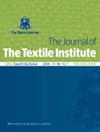Dyeing performance of wool fabric with natural pigment from Cordyceps militaris
IF 1.5
4区 工程技术
Q2 MATERIALS SCIENCE, TEXTILES
引用次数: 0
Abstract
AbstractAs a sustainable and ecological dye resource, the biomass materials are receiving more and more attention. In this work, the pigments in Cordyceps militaris were extracted and applied for dyeing wool fabrics, and the various properties were investigated. The extracted pigments and dyed wool fibers were analyzed and characterized by ultraviolet–visible (UV-Vis) spectroscopy, Liquid Chromatography-Mass Spectrometry (LC-MS) and Fourier Transform Infrared (FTIR) spectroscopy. The single-factor experiments were used to screen and optimize the dyeing process. Six metal mordants with different use order were compared with each other, and their possible mordanting mechanisms were proposed. The color fastnesses, UV resistance and antioxidant properties were evaluated after dyeing. The results showed that UV-Vis, LC-MS and FTIR analysis confirmed that the main components of C. militaris extract was lutein. The optimal dyeing process for the extract was as follows: dyestuff mass 200% (o.m.f.), dyeing temperature 90 °C, dyeing time 45 min, bath pH 5.0, Na2SO4 mass 0 g/L. Metal ions are added to form chelate bonds between the dyes and the fibers, further improving the color fastness. The dyed fabric exhibits excellent UV resistance and its UPF (Ultraviolet Protection Factor) value increases with the color yield. Meanwhile, the dyed wool fabric could exhibit up to 94.77% antioxidant activity. These results provide new insight for the application of C. militaris pigments on wool fabric.Keywords: Cordyceps militariswool fabricluteinmordant dyeingUV resistance AcknowledgmentsThe authors are grateful to the College of Chemistry and Chemical Engineering of WTU and the College of Textiles and Apparel of QNU for providing lab facility.Disclosure statementThe authors have no conflict of interest regarding publishing the article.Additional informationFundingThis research was funded by the Fujian Provincial Natural Science Foundation Projects Program (No.2019J01741), State Key Laboratory of New Textile Materials and Advanced Processing Technology (No. FZ2020014).蛹虫草天然色素对羊毛织物的染色性能
摘要生物质材料作为一种可持续的生态染料资源,越来越受到人们的重视。本研究从蛹虫草中提取色素,并将其应用于羊毛织物的染色,考察其各项性能。采用紫外可见光谱(UV-Vis)、液相色谱-质谱(LC-MS)和傅里叶变换红外光谱(FTIR)对提取的色素和染色的羊毛纤维进行了分析和表征。采用单因素实验对染色工艺进行筛选和优化。对6种不同使用顺序的金属媒染剂进行了比较,并提出了它们可能的媒染剂机理。染色后对其色牢度、抗紫外线性能和抗氧化性能进行了评价。结果表明,UV-Vis、LC-MS和FTIR分析证实,军草提取物的主要成分为叶黄素。提取液的最佳染色工艺为:染料质量200% (o.m.f),染色温度90℃,染色时间45 min,浴液pH 5.0, Na2SO4质量0 g/L。加入金属离子在染料和纤维之间形成螯合键,进一步提高色牢度。染色织物具有优异的抗紫外线性能,其UPF(紫外线防护系数)值随染色率的增加而增加。同时,染色羊毛织物的抗氧化活性可达94.77%。这些结果为军蛾色素在羊毛织物上的应用提供了新的思路。关键词:军用冬虫夏草;羊毛织物;染发剂;抗紫外线;感谢西安交通大学化学化工学院和青海师范大学纺织服装学院提供的实验设备。声明作者在发表文章方面没有利益冲突。福建省自然科学基金项目(No. 2019j01741);纺织新材料及先进加工技术国家重点实验室(No. 2019j01741);FZ2020014)。
本文章由计算机程序翻译,如有差异,请以英文原文为准。
求助全文
约1分钟内获得全文
求助全文
来源期刊

Journal of the Textile Institute
工程技术-材料科学:纺织
CiteScore
4.20
自引率
5.90%
发文量
149
审稿时长
1.0 months
期刊介绍:
The Journal of The Textile Institute welcomes papers concerning research and innovation, reflecting the professional interests of the Textile Institute in science, engineering, economics, management and design related to the textile industry and the use of fibres in consumer and engineering applications. Papers may encompass anything in the range of textile activities, from fibre production through textile processes and machines, to the design, marketing and use of products. Papers may also report fundamental theoretical or experimental investigations, including materials science topics in nanotechnology and smart materials, practical or commercial industrial studies and may relate to technical, economic, aesthetic, social or historical aspects of textiles and the textile industry.
All published research articles in The Journal of The Textile Institute have undergone rigorous peer review, based on initial editor screening and anonymized refereeing by two expert referees.
 求助内容:
求助内容: 应助结果提醒方式:
应助结果提醒方式:


